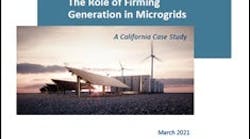The Role of Firming Generation in Microgrids
Interest in microgrids in California is growing because of the increased wildfire risks and subsequent public safety power shutoffs, which de-energize transmission lines in fire-prone sections of the state. Microgrids are ideal solutions for businesses and organizations looking to keep the power on, even when the grid goes down. Determining which type of firm generation, such as a backup generator, fuel cell or linear generator, is best for any given situation can be a challenge.
A new white paper from Mainspring Energy compares the economic and environmental impact of four different microgrid technology solutions. The analysis in the paper, which was originally done for a school and a supermarket in Napa, California, looks at a solar-based microgrid when paired with either a backup generator, battery energy storage, a fuel cell or a Mainspring linear generator.
The goal of the analysis presented in this case study was to determine which microgrid technologies could reliably deliver power during an extended outage, the costs and benefits of each configuration, and the environmental impacts of each. The paper illustrates why Mainspring’s new linear generator technology, which offers distributed, low emission, dispatchable and fuel-flexible power, was the best option.
